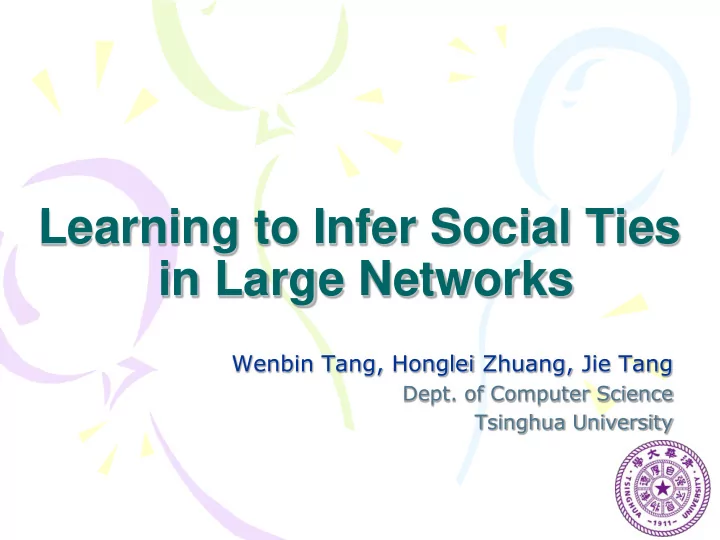

Learning to Infer Social Ties in Large Networks Wenbin Tang, Honglei Zhuang, Jie Tang Dept. of Computer Science Tsinghua University
Real social networks are complex... • Nobody exists only in one social network. – Public network vs. private network – Business network vs. family network • However, existing networks (e.g., Facebook and Twitter) are trying to lump everyone into one big network – FB tries to solve this problem via lists/groups – However … • Google+ which circle? Users do not take time to create it.
Even complex than we imaged! • Only 16% of mobile phone users in Europe have created custom contact groups – users do not take the time to create it – users do not know how to circle their friends • The fact is that our social network is black - …
Example: Mobile network Friends Other Both in office From Home 08:00 – 18:00 08:40 0.89 0.98 From Office 11:35 0.77 From Office From Office 17:55 15:20 0.70 0.63 0.86 From Outside 21:30
Example: Coauthor networks Advisor-Advisee Advisee-Advisor Coauthor
Challenges 1. Relationships in Mobile Network 2. Relationships in Publication Network Challenges: 3. Relationships/Roles in – A generalized framework for inferring social ties? Company Email Network – A scalable, efficient method? CEO Advisor-Advisee Manager How to infer Advisee-Advisor Coauthor Employee
Problem Formulation Input: G =( V,E L ,E U ,R L ,W ) V : Set of Users Friend Partially Other Labeled E L ,R L : Labeled relationships Network ? ? ? E U : Unlabeled relationships Other Output: Input: f : G R G =( V,E L ,E U ,R L ,W )
Basic Idea V 1 V 3 V 2 Friend ? User Node ? ? ? r 24 r 56 Other r 45 Relationship Node
Partially Labeled Pairwise Factor Graph Model (PLP-FGM) Constraint factor h Partially Labeled y 21 =Friend y 21 = advisee h ( y 12 , y 21 ) y 21 Model PLP-FGM y 34 =? y 34 =? y 34 y 34 y 12 y 12 =Friend y 12 = advisor g ( y 45 , y 34 ) g ( y 12 , y 34 ) Latent Variable y 45 Input: Social Network g ( y 12 , y 45 ) y 16 =Other y 16 = coauthor f ( x 2 ,x 1 , y 21 ) v 3 f ( x 3 ,x 4 , y 34 ) v 4 f ( x 1 ,x 2 , y 12 ) Correlation factor g f ( x 3 ,x 4 , y 34 ) f ( x 4 ,x 5 , y 45 ) v 5 r 12 r 34 r 34 v 2 r 45 r 21 v 1 Attribute factors f relationships Problem: Input Model Map relationship to nodes in model For each relationship, identify which type Example : Example : has the highest probability? A makes call to B immediately after the call to C. Call frequency between two users?
Solutions ( con’t ) • Different ways to instantiate factors – We use exponential-linear functions • Attribute Factor: • Correlation / Constraint Factor: – Log-Likelihood of labeled Data:
Learning Algorithm • Maximize the log-likelihood of labeled relationships Expectation Computing Loopy Belief Propagation Gradient Decent Method
Challenges 1. Relationships in Mobile Network 2. Relationships in Publication Network Challenges: 3. Relationships/Roles in – A generalized framework for inferring social ties? Company Email Network – A scalable, efficient method? CEO Advisor-Advisee Manager How to infer Advisee-Advisor Coauthor Employee
Distributed Learning Compute Optimize Gradient with Gradient via LBP Descent Graph Partition Master-Slave Computing
Data Sets • Coauthor Network (Publication) – To infer Advisor-Advisee relationship – Papers from DBLP • Email Network (Email) – To infer Manger-Subordinate relationship – Using Enron Email Dataset • Mobile Network (Mobile) – To infer Friendship – 107 users (ten-month). Published by MIT Unlabeled Labeled Data Set Users Relationships Relationships Publication 1,036,990 1,984,164 6,096 Email 151 3,424 148 Mobile 107 5,122 314
Baselines • Baselines: – SVM: • Use the same feature defined in our model to train a classification model – TPFG: • An unsupervised method to identify advisor-advisee relationships – PLP-FGM-S • Do not use partially-labeled property • Train parameters on the labeled sub-graph
Performance Analysis Data Set Method Precision Recall F 1 -score SVM 72.5 54.9 62.1 TPFG 82.8 89.4 86.0 Publication PLP-FGM-S 77.1 78.4 77.7 PLP-FGM 91.4 87.7 89.5 SVM 79.1 88.6 83.6 Email PLP-FGM-S 85.8 85.6 85.7 PLP-FGM 88.6 87.2 87.9 SVM 92.7 64.9 76.4 Mobile PLP-FGM-S 88.1 71.3 78.8 PLP-FGM 89.4 75.2 81.6 SVM : Use the same feature to train a classification model TPFG : An unsupervised method to identify advisor-advisee relationships PLP-FGM-S :Train PLP-FGM model on the labeled sub-graph
Factor Contribution Analysis Data Set Factor used F 1 -score Attributes 64.9 +Co-advisor 75.0(+10.1%) Publication +Co-advisee 74.7(+9.8%) All 89.5(+24.6%) Attributes 80.3 +Co-recipient 80.6(+0.3%) +Co-manager 83.2(+2.9%) Email 85.0(+4.7%) +Co-subordinate All 87.9(+7.6%) Attributes 80.2 +Co-location 80.4(+0.2%) Mobile +Related-call 80.2(+0.0%) All 81.6(+1.4%)
Distributed Learning Performance
System on
Conclusion • Formulate the problem of inferring the types of social ties • Propose the PLP-FGM model to solve this problem, and present a distributed learning algorithm • Validate the approach in different real data sets
Future work • Make online social networks colorful – How to involve user into learning process? – Connect with social theories?
Thank you! Any Questions?
Correlation Definition • Mobile Dataset: – Co-location • 3 users in the same location. – Related-call • A Make a call to B&C at the same place/time • For more information, please refer to the paper
Feature Definition
Existing Methods… • [Diehl:07] try to identify the relationships by learning a ranking function in Email network. • Wang et al. [Wang:10] propose an unsupervised algorithm for mining the advisor-advisee relationships from the Publication network. • Both algorithms focus on a specific domain – not easy to extend to other problems.
Recommend
More recommend